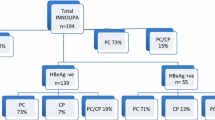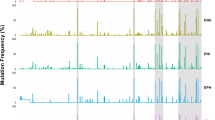Abstract
Purpose
To evaluate the association of hepatitis B virus (HBV) genotypes, basal core promoter (BCP)/precore (PC) and S gene mutations with the clinical-epidemiological characteristics of acute hepatitis B (AHB) in Italy.
Methods
During July 2005–January 2007, 103 symptomatic AHB patients were enrolled and prospectively followed up at 15 national hospitals. HBV genotypes, BCP/PC and S gene variants were determined by nested-PCR and direct sequence analysis.
Results
Genotype D, A and F were detected in 49, 45 and 6 % of patients, respectively. BCP, PC, and BCP plus PC variants were found in 3.1, 11.3 and 7.2 % of patients, respectively. At enrollment, 68.3 % of patients were hepatitis B e antigen (HBeAg)-positive and 31.7 % HBeAg-negative. BCP/PC mutations were more common in HBeAg-negative than in HBeAg-positive patients (p < 0.0001). Compared to genotype D patients, those harboring non-D genotypes were more frequently males (p = 0.023), HBeAg-positive (p < 0.001), had higher bilirubin (p = 0.014) and viremia (p = 0.034) levels and less frequently carried BCP/PC mutations (p < 0.001). Non-D genotype patients more often were from Central Italy (p = 0.001) and reported risky sexual exposure (p = 0.021). Two patients had received vaccination before AHB: one harbored genotype F; the other showed a S gene mutation. Four patients developed fulminant AHB; mutations were found in 2 of 3 patients who underwent BCP/PC sequencing. After a 6-month follow-up, only 2 (2.8 %) patients developed persistent infection.
Conclusion
AHB by non-D genotypes is increasing in Italy and is associated with risky sexual exposure. The ability of some genotypes to cause persistent and/or severe infection in Italy warrants larger studies for clarification.

Similar content being viewed by others
References
Liaw YF, Chu CM. Hepatitis B virus infection. Lancet. 2009;373:582–92.
World Health Organization (WHO). Available, from: http://www.who.int/mediacentre/factsheets/fs204/en/. Updated April 2014.
Romanò L, Velati C, Cambiè G, et al. Hepatitis B virus infection among first-time blood donors in Italy: prevalence and correlates between serological patterns and occult infection. Blood Transfus. 2013;1:281–8.
Stroffolini T, Guadagnino V, Rapicetta M, et al. The impact of a vaccination campaign against hepatitis B on the further decrease of hepatitis B virus infection in a southern Italian town over 14 years. Eur J Intern Med. 2012;23:e190–2.
Fabris P, Baldo V, Baldovin T, et al. Changing epidemiology of HCV and HBV infections in Northern Italy: a survey in the general population. J Clin Gastroenterol. 2008;42:527–32.
Integrated epidemiological system for acute viral hepatitis. Available, from: http://www.iss.it/seieva/. Updated April 2014.
Mele A, Tosti ME, Mariano A, et al. Acute hepatitis B 14 years after the implementation of universal vaccination in Italy: areas of improvement and emerging challenges. Clin Infect Dis. 2008;46:868–75.
Palumbo E, Scotto G, Cibelli DC, et al. Immigration and hepatitis B virus: epidemiological, clinical and therapeutic aspects. East Mediterr Health J. 2008;14:784–90.
Fasano M, Saracino A, Carosi G, et al. Hepatitis B and immigrants: a SIMIT multicenter cross-sectional study. Infection. 2013;41:53–9.
Shi YH. Correlation between hepatitis B virus genotypes and clinical outcomes. Jpn J Infect Dis. 2012;65:476–82.
Lin CL, Kao JH. The clinical implications of hepatitis B virus genotype: recent advances. J Gastroenterol Hepatol. 2011;26:123–30.
Ozasa A, Tanaka Y, Orito E, et al. Influence of genotypes and precore mutations on fulminant or chronic outcome of acute hepatitis B virus infection. Hepatology. 2006;44:326–34.
Ehata T, Omata M, Chuang WL, et al. Mutations in core nucleotide sequence of hepatitis B virus correlate with fulminant and severe hepatitis. J Clin Invest. 1993;91:1206–13.
Dal Molin G, Poli A, Crocè LS, D’Agaro P, et al. Hepatitis B virus genotypes, core promoter variants, and precore stop codon variants in patients infected chronically in North-Eastern Italy. J Med Virol. 2006;78:734–40.
Brunetto MR, Giarin MM, Oliveri F, et al. Wild-type and e antigen-minus hepatitis B viruses and course of chronic hepatitis. Proc Natl Acad Sci USA. 1991;88:4186–90.
De Mitri MS, Cassini R, Morsica G, et al. Virological analysis, genotypes and mutational patterns of the HBV precore/core gene in HBV/HCV-related hepatocellular carcinoma. J Viral Hepat. 2006;13:574–81.
Coppola N, Masiello A, Tonziello G, et al. Factors affecting the changes in molecular epidemiology of acute hepatitis B in a Southern Italian area. J Viral Hepat. 2010;17:493–500.
Scalia G, Russo R, Palermo I, et al. Clinical, virological and epidemiological aspects of acute B hepatitis in the Catania area (Italy). Infez Med. 2010;18:169–74.
Coppola N, Sagnelli C, Pisaturo M, et al. Clinical and virological characteristics associated with severe acute hepatitis B. Clin Microbiol Infect. 2014;20:O991–7. doi:10.1111/1469-0691.12720.
Stroffolini T, Rapicetta M, Lombardo F, et al. Historical study of acute hepatitis B in subjects with or without hepatitis C infection. Eur J Intern Med. 2012;23:e146–9.
Rodella A, Galli C, Terlenghi L, et al. Quantitative analysis of HBsAg, IgM anti-HBc and anti-HBc avidity in acute and chronic hepatitis B. J Clin Virol. 2006;37:206–12.
Chan HL, Hussain M, Lok AS. Different hepatitis B virus genotypes are associated with different mutations in the core promoter and precore regions during hepatitis B e antigen seroconversion. Hepatology. 1999;29:976–84.
Chemin I, Zoulim F, Merle P, et al. High incidence of hepatitis B infections among chronic hepatitis cases of unknown aetiology. J Hepatol. 2001;34:447–54.
Sagnelli C, Ciccozzi M, Pisaturo M, et al. Molecular epidemiology of hepatitis B virus genotypes circulating in acute hepatitis B patients in the Campania region. J Med Virol. 2014;86:1683–93.
Kobayashi M, Ikeda K, Arase Y, et al. Change of hepatitis B virus genotypes in acute and chronic infections in Japan. J Med Virol. 2008;80:1880–4.
Tamada Y, Yatsuhashi H, Masaki N, et al. Hepatitis B virus strains of subgenotype A2 with an identical sequence spreading rapidly from the capital region to all over Japan in patients with acute hepatitis B. Gut. 2012;61:765–73.
Yotsuyanagi H, Okuse C, Yasuda K, et al. Distinct geographic distributions of hepatitis B virus genotypes in patients with acute infection in Japan. J Med Virol. 2005;77:39–46.
van Houdt R, Bruisten SM, Koedijk FD, et al. Molecular epidemiology of acute hepatitis B in the Netherlands in 2004: nationwide survey. J Med Virol. 2007;79:895–901.
Sloan RD, Strang AL, Ramsay ME, et al. Genotyping of acute HBV isolates from England, 1997-2001. J Clin Virol. 2009;44:157–60.
Yotsuyanagi H, Ito K, Yamada N, et al. High levels of hepatitis B virus after the onset of disease lead to chronic infection in patients with acute hepatitis B. Clin Infect Dis. 2013;57:935–42.
Ito K, Yotsuyanagi H, Yatsuhashi H, et al. Risk factors for long-term persistence of serum hepatitis B surface antigen following acute hepatitis B virus infection in Japanese adults. Hepatology. 2014;59:89–97.
Lok AS, Akarca U, Greene S. Mutations in the pre-core region of hepatitis B virus serve to enhance the stability of the secondary structure of the pre-genome encapsidation signal. Proc Natl Acad Sci USA. 1994;91:4077–81.
Chulanov VP, Shipulin GA, Schaefer S, et al. Kinetics of HBV DNA and HBsAg in acute hepatitis B patients with and without coinfection by other hepatitis viruses. J Med Virol. 2003;69:313–23.
Hyams KC. Risks of chronicity following acute hepatitis B virus infection: a review. Clin Infect Dis. 1995;20:992–1000.
Schillie SF, Spradling PR, Murphy TV. Immune response of hepatitis B vaccine among persons with diabetes: a systematic review of the literature. Diabetes Care. 2012;35:2690–7.
Tacke F, Amini-Bavil-Olyaee S, Heim A, et al. Acute hepatitis B virus infection by genotype F despite successful vaccination in an immune-competent German patient. J Clin Virol. 2007;38:353–7.
Ren F, Tsubota A, Hirokawa T, et al. A unique amino acid substitution, T126I, in human genotype C of hepatitis B virus S gene and its possible influence on antigenic structural change. Gene. 2006;383:43–51.
Sticchi L, Caligiuri P, Cacciani R, et al. Epidemiology of HBV S-gene mutants in the Liguria Region, Italy: implications for surveillance and detection of new escape variants. Hum Vaccin Immunother. 2013;9:568–71.
Acknowledgments
The authors thank Lorenzo Fantozzi for his technical assistance. This work was supported in part by the project “Sorveglianze speciali” of the Italian Ministry of the Health (Istituto Superiore di Sanità- Fasc. ISS 1M56.) Abbott Diagnostics Italy has supported this study by providing the reagents for the serological assays and sample transportation from the clinical sites to the reference laboratories.
Conflict of interest
All authors, with the exception of Claudio Galli, Alessandro R. Zanetti and Gloria Taliani, do not have potential competing interests. Claudio Galli is currently employed by Abbott Diagnostics Italy as the Scientific Affairs Manager. Abbott Diagnostics Italy has supported this study by providing the reagents for the serological assays and sample transportation from the clinical sites to the reference laboratories. Alessandro R. Zanetti has received a speaker honorarium from Glaxo Smith Kline and a consulting honorarium from Sanofi Pasteur MSD. Gloria Taliani has received speaker’s honoraria form Bristol-Myers Squibb, Gilead, Janssen Cilag, Merck and AbbVie.
Ethical approval
This study has been performed in accordance with the 1964 Declaration of Helsinki and its later amendments and was approved by the Istituto Superiore di Sanità ethics committee.
Author information
Authors and Affiliations
Consortia
Corresponding author
Additional information
Ornella Zuccaro and Luisa Romanò contributed equally to this work.
Members of the Study Group are listed in the Appendix.
Appendix
Appendix
Members of the Study Group include:
Enzo Raise (Department of Tropical and Infectious Disease, Ospedale dell’Angelo, Mestre, Venezia, Italy); Franklyn Esoka Eseme (Department of Tropical and Infectious Disease, Ospedale dell’Angelo, Mestre, Venezia, Italy); Giuseppe Maio (Division of Infectious Diseases, G. Rummo Hospital, Benevento, Italy); Patrizia Maio (Infectious Diseases Unit, S.G. Moscati Hospital, Avellino, Italy); Cinzia Di Giuli (Infectious Diseases Clinic, Santa Maria Hospital, Terni, Italy); Pietro Bellissima (Infectious Diseases Unit, Gravina Hospital, Caltagirone, Catania, Italy); Salvatore Bonfante (Infectious Diseases Unit, Gravina Hospital, Caltagirone, Catania, Italy); Piergiorgio Chiriacò (Infectious Diseases Unit, A. Perrino Hospital, Brindisi, Italy); Bruno Cacopardo (Department of Clinical and Molecular Biomedicine, Division of Infectious Diseases, University of Catania, Italy); Pierluigi Blanc (Infectious Diseases Unit, Malattie infettive. S. Maria Annunziata Hospital, Firenze, Italy); Stefania Palattella (Clinic of Infectious Diseases, University of Bari, Bari, Italy); Teresa Santantonio (Clinic of Infectious Diseases, University of Bari, Bari, Italy); Angela Guastadisegni (Clinic of Infectious Diseases, University of Bari, Bari, Italy); Pietro Amoroso (Department of Infectious Diseases, Cotugno Hospital, Naples, Italy); Paolo Fabris (Department of Infectious Diseases and Tropical Medicine, S. Bortolo Hospital, Vicenza, Italy); Maria Teresa Giordani (Department of Infectious Diseases and Tropical Medicine, S. Bortolo Hospital, Vicenza, Italy); Vincenzo Vullo (Department of Public Health and Infectious Diseases,University of Rome “Sapienza”Rome Italy), Claudia D’Agostino (Department of Public Health and Infectious Diseases,University of Rome “Sapienza”Rome Italy); Tiziana Giuberti (Unit of Infectious Diseases and Hepatology, Azienda Ospedaliero-Universitaria di Parma, Parma, Italy); Simona Schivazzappa (Unit of Infectious Diseases and Hepatology, Azienda Ospedaliero-Universitaria di Parma, Parma, Italy); Michele Trezzi (Division of Infectious Diseases, “Santa Maria della Misericordia” Hospital, Grosseto, Italy); Gabriella Verucchi (Infectious Diseases Section, Department of Internal Medicine, Geriatric Medicine and Nephrology, University of Bologna, Bologna, Italy); Carlo Biagetti (Infectious Diseases Section, Department of Internal Medicine, Geriatric Medicine and Nephrology, University of Bologna, Bologna, Italy); Daria Pocaterra (Infectious Diseases Section, Department of Internal Medicine, Geriatric Medicine and Nephrology, University of Bologna, Bologna, Italy); Evangelista Sagnelli (Department of Public Medicine, Second University of Naples, Naples, Italy); Vincenzo Messina (Infectious Diseases Unit, A.O.R.N. Sant’Anna e San Sebastiano, Caserta, Italy); Giorgio Antonucci (Clinical Department of Infectious Diseases, National Institute for Infectious Disease, L. Spallanzani, Rome, Italy); Francesco Vairo (Clinical Department of Infectious Diseases, National Institute for Infectious Disease, L. Spallanzani, Rome, Italy); Marcello Marinelli, (Microbiology, IRCCS San Raffaele, Milan, Italy); Sara Paladini, Catia Tagliacarne (University of Milan, Department of Biomedical Sciences for Health, Milan, Italy).
Rights and permissions
About this article
Cite this article
Zuccaro, O., Romanò, L., Mele, A. et al. Clinical, epidemiological and virological features of acute hepatitis B in Italy. Infection 43, 431–441 (2015). https://doi.org/10.1007/s15010-015-0747-0
Received:
Accepted:
Published:
Issue Date:
DOI: https://doi.org/10.1007/s15010-015-0747-0




